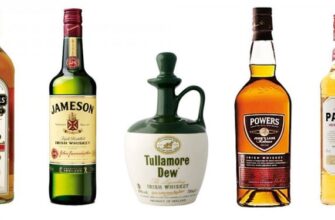When I got the idea to write an article about Scotch whiskey, it was already quite cold outside, and winter was gradually coming to the whole territory of Russia. It is in the cold and dank seasons, sometimes, after a working day, you want to warm up, perhaps your favorite strong drink – whiskey.
For many centuries it was Scotland that was the leader in the production of whiskey, so they have achieved an incredible variety of tastes and smells of this wonderful drink. The efforts that Scotland's distillers are making to perfect their national beverage is exciting. It seems that for them there is no limit of perfection. That is why this article is about Scotch Whiskey.
- Scotch whiskey history
- Scotch whiskey types
- 1. Single Malt Scotch Whiskey
- 2. Grain Scotch Whiskey
- 3. Blended Scotch Whiskey
- 4. Malt blended Scotch whiskey
- 5. Grain blended Scotch whiskey
- The myth of two-malt and three-malt whiskey
- The name 'Scotch'
- Whiskey production
- Whiskey production areas in Scotland
- The Highlands
- The Lowlands
- Speyside
- Campbeltown (Campbeltown)
- Islay (Isla)
- Whiskey tasting
- What whiskey is drunk from
- How to drink whiskey basics
- How to drink whiskey, process
- Whiskey recommendations
- Whiskey from The Highlands
- Whiskey from The Lowlands
- Whiskey from the Speyside area
- Islay whiskey
- In conclusion
- Rating of 300+ whiskeys
Scotch whiskey history
The first written mention of whiskey was found in the records of the Scotland Treasury Tax, which are dated June 1, 1495. The notes stated, 'By order of the king, give Brother John Cora eight boxes of malt for the' water of life 'made.' '
'The water of life' – this was the name given earlier to an alcoholic drink that was driven from malt. Subsequently, the drink was given the name – whiskey. If you count the amount of whiskey you get from 8 boxes of malt, you get about 1,500 bottles, which the monk John produced in 1494.
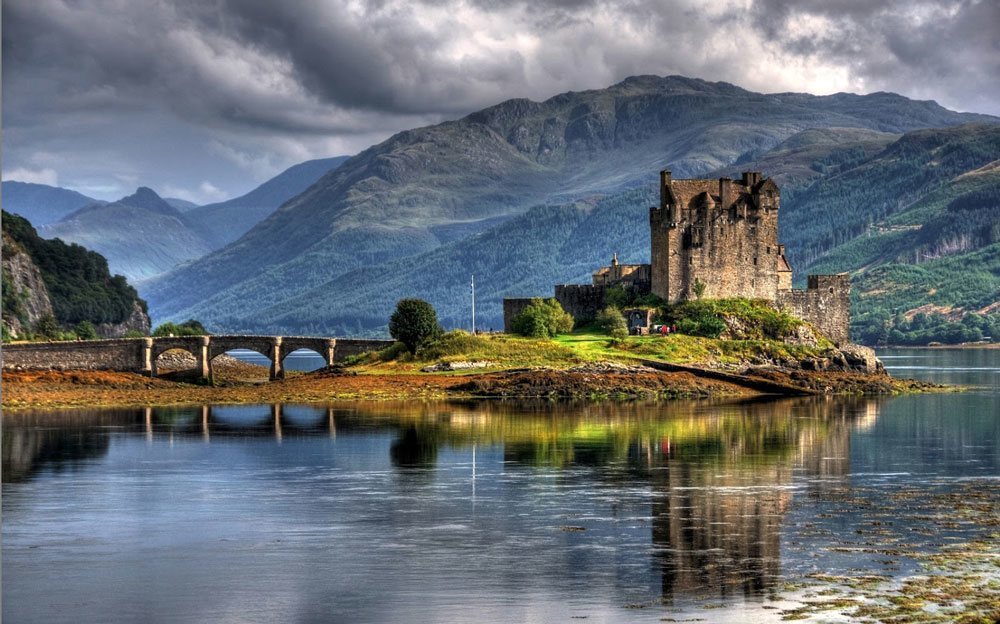 Scotland
Scotland
For decades, whiskey has been gaining popularity throughout Scotland. In 1644, the government began levying taxes on whiskey producers in order to generate income from the drink and control all production. However, despite all attempts to regulate and receive income from distillers, people began to produce whiskey clandestinely and this activity flourished more than ever.
By 1780, Scotland had 8 official distilleries and over 400 underground. By 1823, the local parliament realized that it would be possible to bring producers out of the shadows only by easing tax collections. This is how the 'Excise Act' was born.
The popularity of Scotch whiskey gained momentum again by 1831 with the advent of a new production method. Now, thanks to new technology, distilleries were able to produce softer alcohols at a significantly lower cost.
In 1880, Scotch whiskey began its worldwide expansion thanks to a small insect that devoured vineyards in France. Vineyards began to be cut down en masse, which led to a drop in the production of wine and cognac. And since wine and cognac were the most popular drinks that were consumed every day, they had to be replaced with something. Actually, Scotch whiskey has become a new popular drink all over the world.
Scotch whiskey types
There are two main types of Scotch whiskey in the world: single malt and grain. Of these types, 3 subcategories still stand out: blended, malt blended, grain blended.
 Scotch whiskeys
Scotch whiskeys
1. Single Malt Scotch Whiskey
Single malt Scotch whiskey is by far the most popular type of whiskey in the world. Basically, it is a whiskey produced in a single distillery using malted barley (malt) and water. Single malt whiskey contains no other grains and must be produced exclusively in Scotland.
2. Grain Scotch Whiskey
Grain Scotch whiskey is less common in the world. Whole grain whiskey is produced using malt, water, and various grains or cereals. Grain Scotch whiskey should be produced in one distillery and only in Scotland, where it gets the name 'Scotch'. It is from this type of whiskey that various blends are made.
3. Blended Scotch Whiskey
This type of Scotch whiskey is made from at least one or more single malt whiskeys to be blended with one or more grain-based Scotch whiskeys produced in different distilleries.
4. Malt blended Scotch whiskey
Malt blended Scotch whiskey is actually one of the most unusual whiskeys to be found today. Basically, it is a blended whiskey made from several single malt Scotch whiskeys that have been produced in different distilleries. Previously, this whiskey was called 'Pure Malt'.
5. Grain blended Scotch whiskey
Grain blended Scotch whiskeys are very similar to malt blended whiskeys, except that they use two or more whole grain Scotch whiskeys from different distilleries. Then all this is mixed and the product is obtained.
The myth of two-malt and three-malt whiskey
Surely someone has heard of 'two malt' or 'three malt' whiskey. In fact, this is nothing more than a marketing ploy by the producers of single malt whiskey. Essentially, the word 'two-malt whiskey' means that the whiskey was settled in two different oak barrels.
The name 'Scotch'
While most consumers have a general idea that Scotch whiskey should always come from Scotland, few realize that in fact, the production of this drink is based on a regulatory legal act that regulates everything from the size of the bottle, to the process of grinding malt. .
The title of 'Scotch' is defined and governed by UK legislation called 'The Scotch Whiskey Regulations 2009 No.2890' or SWR. The act regulates whiskey production technology, packaging, labeling, even advertising within the UK; the rest of the world is under SWR.
- The whiskey must be produced in a distillery in Scotland from water and malt, to which only whole grains of other grains can be added. Moreover, the grains themselves in the production process must be:
- Processed and made into a homogeneous mass.
- Transformed into fermentable substrate only by endogenous enzymes.
- Fermented with yeast only.
- The concentration of alcohol after distillation is not less than 94.8%.
- The whiskey must be 'matured' in a regulated excise warehouse in Scotland in oak barrels with a capacity of no more than 700 liters for at least three years.
- Scotch whiskey must retain the color, aroma and flavor of the raw materials from which it was made.
- Scotch whiskey must not contain any substance other than water and E150A sugar color.
- The minimum percentage of alcohol in the final product is 40%.
Whiskey production
Whiskey production starts with water. It is for this reason that many distilleries are located near the pure source. It used to be difficult to deliver clean water, so distilleries were abundantly built near water bodies.
 Whiskey production, distillation
Whiskey production, distillation
One of the specialties of Scotch whiskey is that the water in Scotland is very 'soft' and contains few minerals. The western territories of Scotland, especially the islands, are characterized by water with a high content of peat. In swampy areas, water flows through peat bogs, which are even brownish. There is no direct evidence that this particular water gives the whiskey a peaty flavor; however, many distilleries protect their springs and are proud of them.
There is no legal reason to use barley grown exclusively in Scotland in production. However, the vast majority of distilleries use local barley, probably for economic reasons.
After the water is prepared, it is poured into various vessels and tanks and malted barley is produced. The grains are soaked in water and left for several days in order for them to germinate. Then they are dried with hot air or peat smoke, which stops the growth of barley shoots and prevents them from rotting. Further, most distilleries grind malted barley, but there are still adherents of the traditional production method, which allows the barley to be used whole, without grinding.
Now that the malted barley is prepared, it is poured into a special kettle and water is poured. At a certain temperature, the mixture ferments and turns into a dark slurry called wort. Next comes the fermentation process. The wort is pumped into a wooden or stainless steel barrel. While stirring the wort, yeast is added to the barrels. Within 48 hours, carbon dioxide is released and the wort is converted to alcohol.
The next step is to distill the whiskey. In fact, the alcohol extraction technology does not differ from what was used even in our country for the production of moonshine. Only the volumes are different. After the first run, a liquid is obtained with an alcohol concentration of about 28%. The process is repeated until the proportion of alcohol is about 70%. Then the liquid is poured into oak barrels and allowed to infuse for at least 3 years. Remarkably, the barrels are not airtight, so the whiskey will get a different smell from the location and storage of the barrels.
Whiskey production areas in Scotland
Scotland is divided into 5 distinct districts, where distilleries produce a variety of whiskeys, each with its own unique flavor.

The Highlands
The whiskey produced in this area is known for its medium strength. Today there are many distilleries that produce whiskey in the area, including: Aberfeldy, Balblair, Ben Nevis, Clynelish, The Dalmore, Dalwhinnie, Glen Ord, Glenmorangie, Oban and Old Pulteney. Distilleries are located on the islands: Arran, Jura, Tobermory, Highland Park and Scapa, as well as Talisker. While many whiskey connoisseurs believe that the islands should have their own neighborhood, they still belong to The Highlands.
The Lowlands
Whiskey produced in this area is considered softer and more delicate. Very often local distilleries do without peat drying the malt, hence the light taste. Today the following distilleries operate: Auchentoshan, Bladnoch, Glenkinchie and Daftmill. The last distillery should release its first batch of whiskey only in 2015, as it opened relatively recently.
Speyside
The most expensive and famous whiskey is produced in this area of Scotland. Distilleries include Aberlour, The Balvenie, Cardhu, Cragganmore, Glenfarclas, Glenfiddich, Glenglassaugh, The Glenlivet, Glen Moray and The Macallan.
Campbeltown (Campbeltown)
Typically, whiskey from this area is not under 10 years old. Currently active production is carried out by: Glen Scotia, Glengyle and Springbank.
Islay (Isla)
Islay whiskey has the most pronounced taste and aroma. Due to the large amount of peat, the whiskey turns out to be of a dark caramel color with the taste of peat, iodine, algae and salt. Today, 8 distilleries are involved in production: Ardbeg, Bowmore, Bruichladdich, Bunnahabhain, Caol Ila, Kilchoman, Lagavulin and Laphroaig.
Whiskey tasting
Nowadays, Scotch whiskey is drunk in various flavors, ranging from pure drinking to dozens of cocktails. However, connoisseurs of this drink do not accept mixing, for example, 15 year old whiskey with soda. Only in pure form or slightly diluted with water. If you are visiting a whiskey connoisseur, most likely, first you will be offered a drink in its pure form, secondly with water, thirdly with ice, and lastly whiskey and cola (the connoisseur may not offer the last cocktail).
What whiskey is drunk from
In bars, clubs and restaurants you will be offered a transparent cylindrical glass with a thick bottom. Such a glass is called – rox. However, die-hard whiskey aficionados or tasters choose tulip-shaped glasses. According to experts, this glass allows you to appreciate all the notes of taste and smell of whiskey, concentrating the aroma.
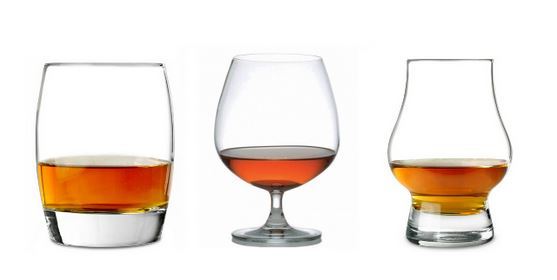 Whiskey glasses
Whiskey glasses
How to drink whiskey basics
The best way to drink whiskey is pure. A drink at room temperature (17-20 Celsius is ideal), allows you to enjoy the aroma and aftertaste of whiskey. However, most people prefer to chill whiskey and add ice cubes to everything else. With each piece of ice, whiskey loses its uniqueness due to the dilution of water in it. In addition, the cold 'closes' the whiskey aroma and you risk not catching the taste.
I would recommend putting no more than 2 ice cubes in a glass and not waiting for them to completely dissolve. Otherwise, you will not be able to tell whether it is diluted cognac or whiskey.
Recently, whiskey stones have become popular. Their principle is simple: you put stones in the refrigerator, they cool there and, if necessary, you add these chilled stones instead of ice cubes to a glass of whiskey. In my opinion, this is another marketing ploy that makes you spend extra money. They do nothing special, they only give a reason to brag about the presence of stones in a glass, nothing more.
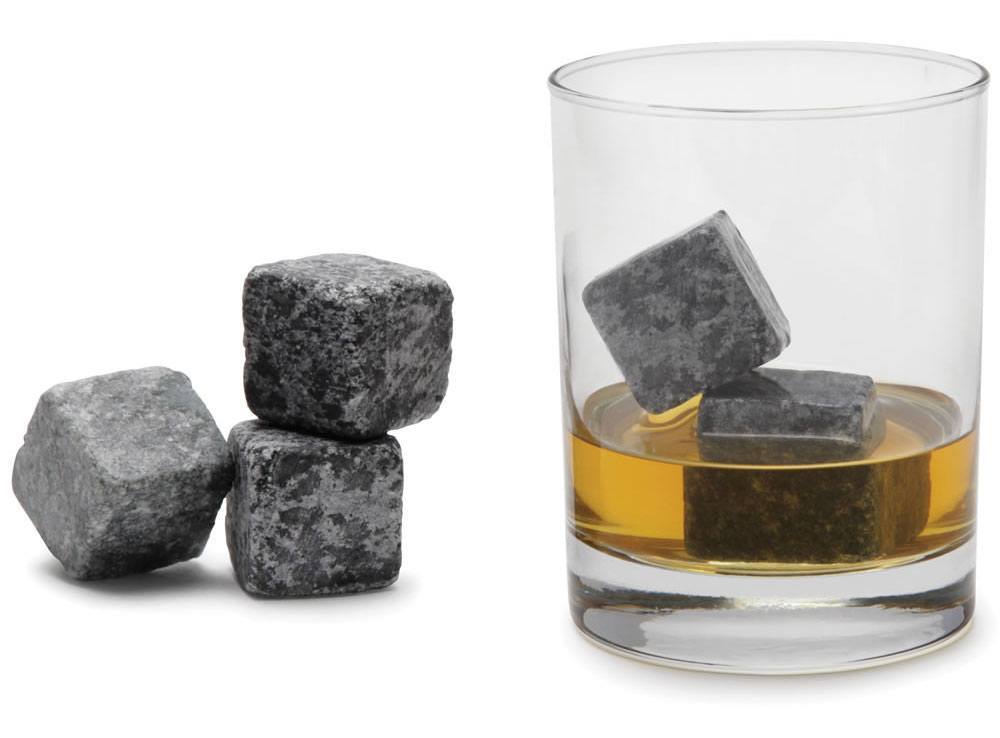 Whiskey with stones
Whiskey with stones
The classic use of whiskey is 50/50 diluted with clean water. Although some think that this is only to reduce the concentration of alcohol, nevertheless, the drink turns out to be aromatic and no less tasty.
True connoisseurs of whiskey, as well as professional tasters, recommend rinsing the glass with the same whiskey before starting. Those. You pour a small amount into a washed glass and whisk the whiskey so that all the sides of the vessel are washed with whiskey. Next, pour this whiskey into the sink. A clean glass of foreign odors is ready for drinking and will not let other odors interfere with enjoying your whiskey. You can consider this a waste of whiskey, but experts say that even the water with which they washed the glass has a smell and must be removed.
How to drink whiskey, process
Pour the whiskey into a clean glass. Rotate the glass with the drink so that it rolls along the walls without splashing out over the edges. See how the leftover whiskey drips on the sides of the glass. The thicker and more oily whiskey you drink, the slower the residue will flow down the walls.
Now that you have looked at your whiskey, bring the glass to your nose and take a deep breath through your nose and mouth, smelling the aroma of the drink as you exhale. Do not bring the glass too close, or the alcohol fumes can take your breath away.
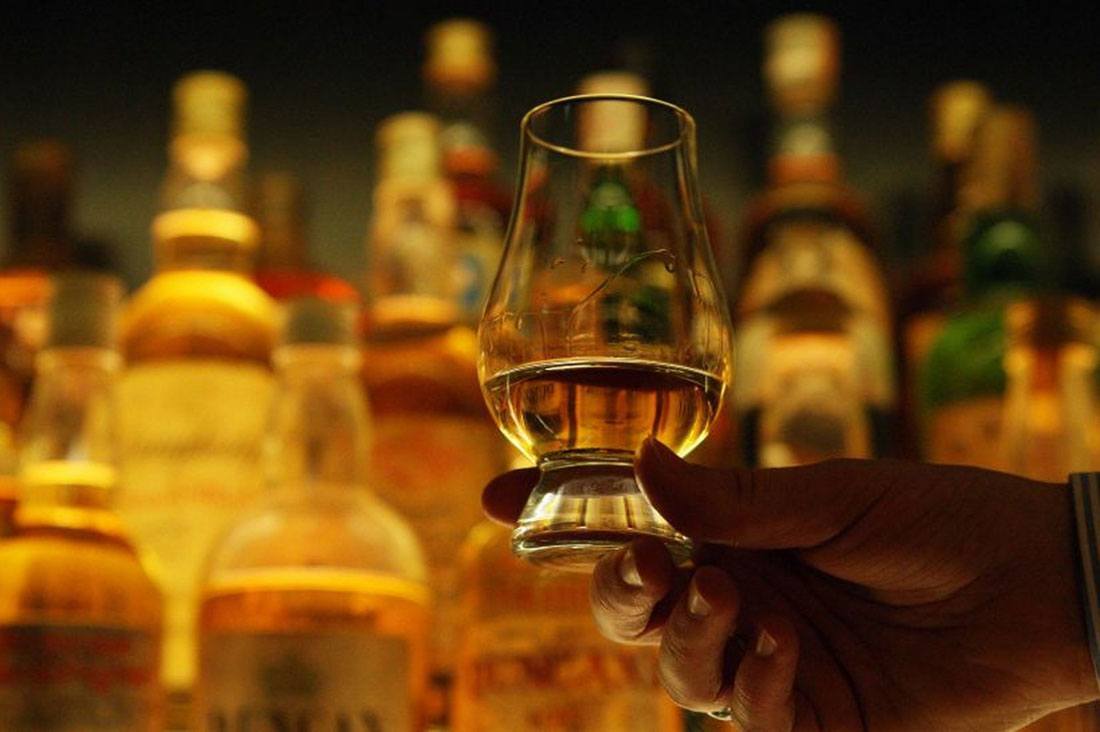 How to drink whiskey, the tasting process
How to drink whiskey, the tasting process
Repeat the operation several times: turn the whiskey -> bring it to the nose -> inhale the aroma. Each time, the taste and aroma of the whiskey will change. Try to feel all the shades and enjoy the bouquet of aromas.
Next, pour some cool, still water into a glass and sip the drink. Try chatting a whiskey in your mouth so that all receptors taste. This is how you will feel all its subtleties. Swallow the drink, take a breath and try to sip more of your whiskey from the glass.
Whiskey recommendations
Scotch whiskey is slowly gaining popularity in Russia and people are beginning to understand good alcohol. Of course, everyone has their own taste, but you can give some recommendations for choosing a good whiskey, which has only proven itself from the best side in the old world.
Whiskey from The Highlands
- Highland Park is 12 years old.
- Scapa is 16 years old.
- Talisker is 18 years old.
Whiskey from The Lowlands
- Auchentoshan Three Wood.
- Glenkinchie is 12 years old.
- Rosebank is 12 years old.
Whiskey from the Speyside area
- The Macallan Fine Oak.
- The Macallan is 12 years old.
- The Macallan is 25 years old.
- Aberlour is 12 years old.
- Aberlour A'bunadh.
- The Balvenie Doublewood.
Islay whiskey
- Bowmore is 18 years old.
- Lagavulin is 16 years old.
- Caol Ila Moch.
- Laphroaig is 12 years old.
In conclusion
Scotch whiskey has always been and most likely will not be a drink for everyone. Someone adores it and prefers to drink it in a cozy home environment, savoring every sip. Someone hates whiskey and prefers something else. In any case, the taste and color of a friend is not.
For those who just want to start tasting such a noble drink as Scotch whiskey, I recommend starting with milder varieties such as Auchentoshan 12 years old or the Dalwhinnie 15 years old. You shouldn't rate whiskey starting with White Horse or Grant's, as there is more alcohol than taste.
And one more little piece of advice for those people who like to collect guests. Store expensive and less expensive whiskey separately. At the moment when people ask you to try first one, then another, without understanding whiskey, you risk ruining yourself with good alcohol, the value of which is not understood by everyone. Therefore, keep 1-2 bottles of average quality in the bar, for example, Jameson or Jack Daniel's, so that later you will not be so bitter to look at the drunk bottle of whiskey worth $ 300, which you loved to sip in the evenings. Treat those who understand good alcohol.
Rating of 300+ whiskeys
By the way, we have prepared a rating of 300+ whiskey sorts from around the world with a description of the smell, taste and aftertaste of this drink. Go to the whiskey ranking, according to bowandtie.ru >>>
Thank you for your attention, I hope you enjoyed reading about my favorite alcoholic drink – whiskey from Scotland. Good luck and may only the best whiskey be on your table.



